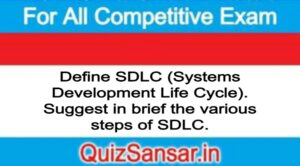
Define SDLC (Systems Development Life Cycle). Suggest in brief the various steps of SDLC.
Define SDLC (Systems Development Life Cycle). Suggest in brief the various steps of SDLC.
Ans.
The Systems Development Life Cycle (SDLC), or Software Development Life Cycle in systems engineering, information systems and software engineering, is the process of creating or altering systems, and the models and methodologies that people use to develop these systems. The concept generally refers to computer or information systems. Emphasis on this article (SDLC) is on man-made technological life-cycle. But there are many other life-cycle models to choose from. This includes ecological life cycles, for every life cycle, whether biological or technological, has a beginning and an end.
A number of system development life cycle (SDLC) models have been created waterfall, fountain, spiral, build and fix, rapid prototyping, incremental, and synchronize and stabilize.
The oldest of these, and the best known, is the waterfall: a sequence of stages in which the output of each stage becomes the input for the next. These stages can be characterized and divided up in different ways, including the following:
◆Project planning, feasibility study: Establishes a high-level view of the intended project and determines its goals.
◆ Systems analysis, requirements definition: Refines project goals into defined functions and operation of the intended application. Analyzes end-user information needs.
◆ Systems design: Describes desired features and operations in detail, including screen layouts, business rules, process diagrams, pseudocode and other documentation.
◆ Implementation: The real code is written here.
◆ Integration and testing: Brings all the pieces together into a special testing environment, then checks for errors, bugs and interoperability.
◆ Acceptance, installation, deployment: The final stage of initial development, where the software is put into production and runs actual business.
◆ Maintenance: What happens during the rest of the software’s life: changes, correction, additions, moves to a different computing platform and more. This, the least glamorous and perhaps most important step of all, goes on seemingly forever.
Starting the Systems Development Process: Do we have E-business opportunities? What are our E-business priorities? How can information technologies provide information system solutions? These questions have to be answered in the systems investigation stage- the first step in the systems development process. This stage may involve consideration of proposals generated by an E-business planning process. The investigation stage also includes the preliminary study of proposed solutions to meet a company’s E-business priorities and opportunities.
Feasibility Studies: The systems investigation stage requires a preliminary study called a feasibility study. A feasibility study is a preliminary study where the information needs of prospective users and the resource requirements, cost, benefits and feasibility of a proposed project are determined. The findings of this study can be documented in a written report that includes preliminary specification and a development plan for a proposed E-business application. If management approves the recommendations of the feasibility study, the development process can continue.
The focus of organizational feasibility is on how well a proposed system supports the strategic E-business priorities of the organization. Economic feasibility is concerned with whether expected cost savings, increased revenue, increased profits, reduction in required investment and other types of benefits will exceed the costs of developing and operating a proposed system.
Technical feasibility can be acquired if reliable hardware and software capable of meeting the needs of a proposed system can be acquired or developed by the business in the required time. Finally, operational feasibility is the willingness and ability of the management, employees, customers, suppliers and others to operate, use, and support a proposed system. For example, if the software for a new E-commerce system is too difficult to use, customers may make too many errors and avoid using it. Thus, it would fail to show operational feasibility.
Cost/Benefit Analysis: Feasibility studies typically involve cost/benefit analysis. If costs and benefits can be quantified, they are called tangible; if not, they are called intangible. Examples of tangible costs are the cost of hardware and software, employee, salaries etc. Intangible costs include the loss of customer goodwill or employee morale caused by errors and disruptions.






